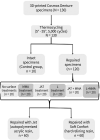Effect of repair methods and materials on the flexural strength of 3D-printed denture base resin
- PMID: 36452364
- PMCID: PMC9672696
- DOI: 10.4047/jap.2022.14.5.305
Effect of repair methods and materials on the flexural strength of 3D-printed denture base resin
Abstract
Purpose: The aim of this study was to evaluate the flexural strength of a 3D-printed denture base resin (Cosmos Denture), after different immediate repair techniques with surface treatments and thermocycling.
Materials and methods: Rectangular 3D-printed denture base resin (Cosmos Denture) specimens (N = 130) were thermocycled (5,000 cycles, 5℃ and 55℃) before and after the different repair techniques (n = 10 per group) using an autopolymerized acrylic resin (Jet, J) or a hard relining resin (Soft Confort, SC), and different surface treatments: Jet resin monomer for 180 s (MMA), blasting with aluminum oxide (JAT) or erbium: yttrium-aluminum-garnet laser (L). The control group were intact specimens. A three-point flexural strength test was performed, and data (MPa) were analyzed by ANOVA and Games-Howell post hoc test (α = 0.05). Each failure was observed and classified through stereomicroscope images and the surface treatments were viewed by scanning electron microscope (SEM).
Results: Control group showed the highest mean of flexural strength, statistically different from the other groups (P < .001), followed by MMA+J group. The groups with L treatment were statistically similar to the MMA groups (P > .05). The JAT+J group was better than the SC and JAT+SC groups (P < .05), but similar to the other groups (P > .05). Adhesive failures were most observed in JAT groups, especially when repaired with SC. The SEM images showed surface changes for all treatments, except JAT alone.
Conclusion: Denture bases fabricated with 3D-printed resin should be preferably repaired with MMA+J. SC and JAT+SC showed the worst results. Blasting impaired the adhesion of the SC resin.
Keywords: Dental prosthesis; Denture bases; Flexural strength; Printing; Resins; Three-dimensional.
© 2022 The Korean Academy of Prosthodontics.
Figures





Similar articles
-
Repair strength of 3D-printed denture base resins: Effect of surface treatment and repair material type.J Prosthodont. 2024 Aug 27. doi: 10.1111/jopr.13925. Online ahead of print. J Prosthodont. 2024. PMID: 39188160
-
Effect of different surface treatments on surface roughness and flexural strength of repaired 3D-printed denture base: An in vitro study.J Prosthet Dent. 2021 Oct;126(4):595.e1-595.e8. doi: 10.1016/j.prosdent.2021.07.005. Epub 2021 Aug 6. J Prosthet Dent. 2021. PMID: 34366117
-
Effect of repair resin type and surface treatment on the repair strength of heat-polymerized denture base resin.J Prosthet Dent. 2014 Jan;111(1):71-8. doi: 10.1016/j.prosdent.2013.09.007. Epub 2013 Oct 22. J Prosthet Dent. 2014. PMID: 24161257
-
Evaluation of Shear Bond Strength Between Denture Teeth and 3D-Printed Denture Base Resin.J Prosthodont. 2023 Apr;32(S1):3-10. doi: 10.1111/jopr.13527. Epub 2022 Jun 16. J Prosthodont. 2023. PMID: 35609138
-
Influence of Thermocycling and Surface Treatments on the Flexural Strength of Denture Base Resin: An In Vitro Study.J Contemp Dent Pract. 2022 Aug 1;23(8):788-792. doi: 10.5005/jp-journals-10024-3387. J Contemp Dent Pract. 2022. PMID: 37283012
Cited by
-
Effect of Different Surface Treatments as Methods of Improving the Mechanical Properties after Repairs of PMMA for Dentures.Materials (Basel). 2024 Jul 2;17(13):3254. doi: 10.3390/ma17133254. Materials (Basel). 2024. PMID: 38998337 Free PMC article.
-
Wettability of Heat Cured Acrylic Resin Interlaciated With Recycled Poly Methyl Methacrylate: An In Vitro Study.J Int Soc Prev Community Dent. 2024 Oct 29;14(5):421-428. doi: 10.4103/jispcd.jispcd_10_24. eCollection 2024 Sep-Oct. J Int Soc Prev Community Dent. 2024. PMID: 39677534 Free PMC article.
-
Evaluation of mechanical properties and color stability of 3D-printed denture base materials following two surface treatments.BMC Oral Health. 2025 Apr 30;25(1):671. doi: 10.1186/s12903-025-06056-5. BMC Oral Health. 2025. PMID: 40307743 Free PMC article.
-
Microbial adhesion and biofilm formation by Candida albicans on 3D-printed denture base resins.PLoS One. 2023 Oct 4;18(10):e0292430. doi: 10.1371/journal.pone.0292430. eCollection 2023. PLoS One. 2023. PMID: 37792886 Free PMC article.
-
Bond Strength of Nanocomposite Hard Liner to CAD-CAM Milled, 3D Printed, and Conventionally Fabricated Denture Base Resins.Dent J (Basel). 2024 Aug 23;12(9):275. doi: 10.3390/dj12090275. Dent J (Basel). 2024. PMID: 39329841 Free PMC article.
References
-
- Alghazzawi TF. Advancements in CAD/CAM technology: Options for practical implementation. J Prosthodont Res. 2016;60:72–84. - PubMed
-
- Tasaka A, Matsunaga S, Odaka K, Ishizaki K, Ueda T, Abe S, Yoshinari M, Yamashita S, Sakurai K. Accuracy and retention of denture base fabricated by heat curing and additive manufacturing. J Prosthodont Res. 2019;63:85–89. - PubMed
-
- Kalberer N, Mehl A, Schimmel M, Müller F, Srinivasan M. CAD-CAM milled versus rapidly prototyped (3D-printed) complete dentures: An in vitro evaluation of trueness. J Prosthet Dent. 2019;121:637–643. - PubMed
-
- Prpić V, Schauperl Z, Ćatić A, Dulčić N, Čimić S. Comparison of mechanical properties of 3D-Printed, CAD/CAM, and conventional denture base materials. J Prosthodont. 2020;29:524–528. - PubMed
LinkOut - more resources
Full Text Sources

